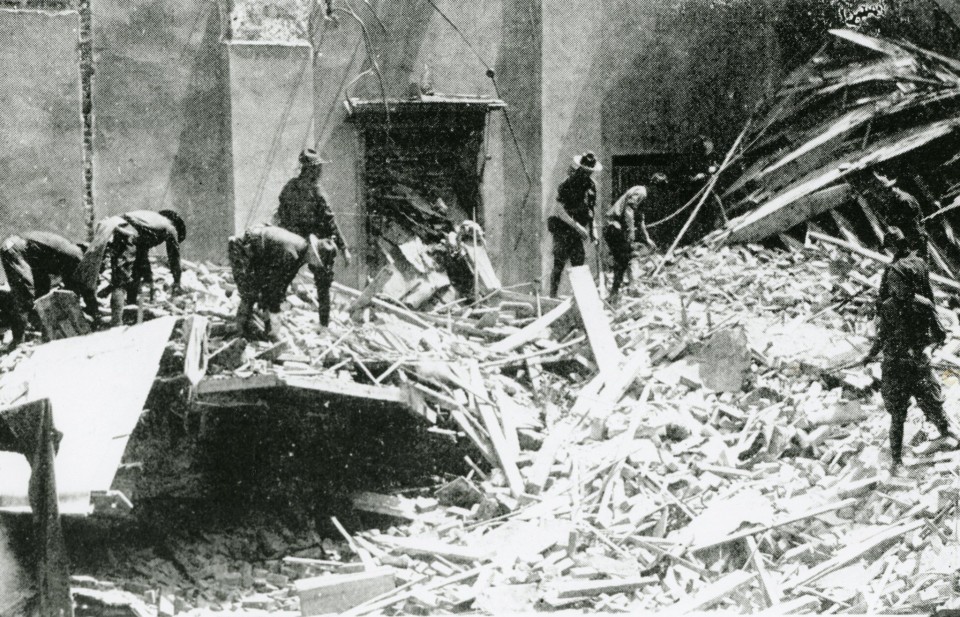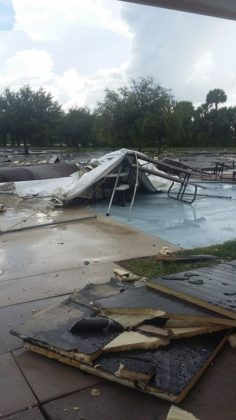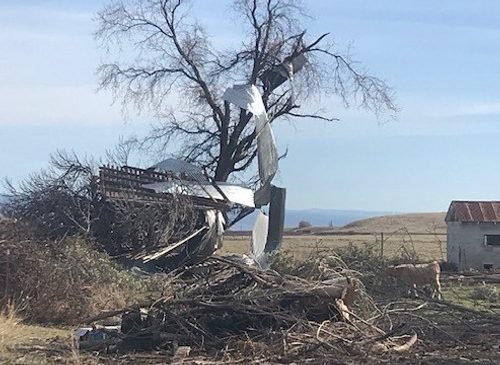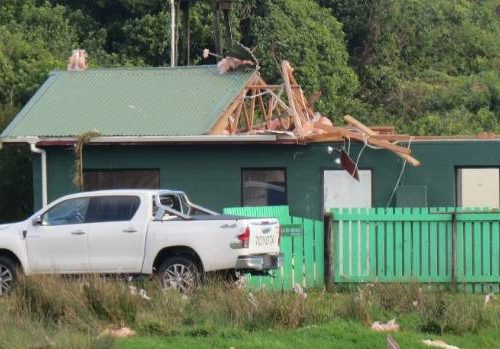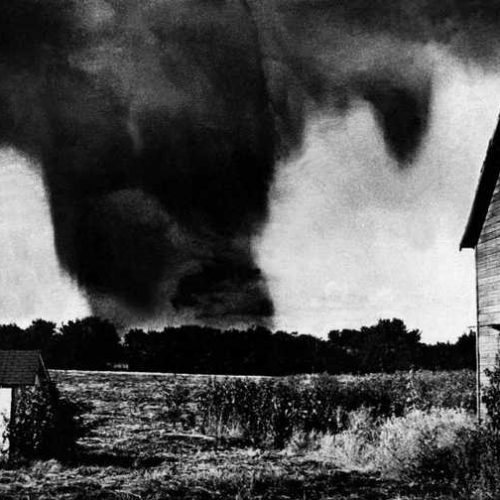LORAIN, Ohio — Ninety-two years ago, a “monster” tornado spun off Lake Erie and struck the city of Lorain, killing 78 people and injuring hundreds more, making it the deadliest tornado in Ohio history.
Add the seven people killed minutes before when the same tornado touched down in Sandusky, and the death toll rises to 85, making it the 24th deadliest tornado in United States history, a record that holds true today, according to the National Oceanic and Atmospheric Administration.
Today, a humble plaque at 383 Broadway marks the spot where the State Theater, also known as the Majestic Theater, collapsed from the tornado on June 28, 1924, killing 15 children who were attending the Saturday afternoon matinee. Another 200 patrons, mostly children, were trapped in the wreckage. Many suffered severe injuries.
The Lorain Historical Society records show that in mere minutes, the tornado tore through the downtown district of the thriving lakeside city of 40,000 people. Turning east, it tore through the poorer neighborhoods of the city where it committed further destruction to homes and businesses.
Rescue workers from all over Ohio converged to sift through the rubble. They found hundreds of people, some alive, some injured so badly that they never recovered. Bodies and living victims were found in the lake, up trees, under rubble and hidden in weedy fields.
In all, 681 houses were destroyed by the tornado and thousands more damaged, leaving 7,000 people homeless. Hundreds of businesses were destroyed or badly damaged and needed to close. Many never reopened. More than 250 churches, schools and restaurants were damaged or destroyed.
Violet Nore was 6 years old when the tornado hit. She was one of the last survivors until her death this past March at 98. Her fiance of 28 years, Sam Ristas of Elyria, said she would sometimes talk about the tornado and the catastrophic impact it had on her life.
“She told me she was out picking strawberries one day, just a few blocks from her home on Main Street,” Ristas recalled. “She looked up and saw that the sky had turned different colors. It scared her, so she ran home. Just as she got into the house, the tornado hit and tore the house to pieces.
“She was picked up by the tornado, even though she held onto a table leg, and was thrown three blocks away into a ditch,” he continued. “She still had scars on her legs and scalp from the wounds she suffered that day.”
He said other members of her family were also injured by the tornado.
“Her sister was picked up and thrown up into a tree,” Ristas said. “Her mother was torn out of the street car she was riding in and suffered a broken arm. Her father hung onto a horse-drawn milk wagon to avoid being swept up by the tornado, but his clothes were torn right off his back.”
Ristas said the National Guard came in to help the survivors. Nore and her family lived in a tent for several months, existing mostly on beans they cooked on a Bunsen burner. She and her family moved into the Longfellow School with other displaced persons for the winter.
“Her father (Dennis Veres) rebuilt their home brick by brick,” Ristas said. “He would walk around the city and gather bricks that were laying around. Violet said as a child she helped him and picked up bricks.”
Ristas said that Nore never forgot that horrific day and how much it frightened her.
It’s no surprise some people thought it was the end of the world.
According to the “Official Souvenir and Memorial Book of the Lorain Tornado,” published later in 1924, people “Thought it was the Day of Reckoning. They accepted their fate, kneeled down and prayed, firm in their belief that the end of the world was at hand.”
The book, “The 1924 Tornado in Lorain & Sandusky” by Betsy D’Annibale, tells of the day and the tornado that lasted mere minutes but changed the lives of thousands forever.
The tornado first hit the city of Sandusky, about 30 miles west of Lorain, at 4:30 p.m. that Saturday on June 28. It came off the lake and tore up the city’s downtown district before it retreated to the lake and headed east toward Lorain. Some reports say the storm merged with a second one in Lake Erie, which produced the giant tornado that hit Lorain.
At 4:55 p.m. that afternoon, a man driving a car just west of Lorain, said he saw a “dense black wall” in the sky above the lake, according to D’Annibale’s book. He was so frightened, he stopped and took his family to shelter at the Lorain Country Club.
“(The tornado) was cone shaped, pointing downward, the cloud being 100 to 150 feet at the top and 20 feet wide where it touched the water,” D’Annibale wrote. “The air was extremely oppressive, breathing seemed to be difficult, and noise was terrific…making a noise like a fire engine siren.”
The tornado hit Lakeview Park Beach in Lorain at 5:05 p.m. and four minutes later tore through the downtown business district, causing more than a billion dollars worth of damage in today’s dollars.
It tossed around a 90-car freight train like toys, some of its cars landing in fields 300 feet from the tracks, according to D’Annibale and newspaper reports. The Plain Dealer reported at the time that cows 100 miles away in Conneaut, Ashtabula County, were cut by glass blown there from Lorain. Ashtabula County residents found family photos, letters and cancelled checks from Lorain on their land.
Bill Bird, executive director of the Lorain County Historical Society, said the tornado is an unforgettable event.
“I remember reading one story vividly about two girls who were in a clothing store,” he said. “Just before the tornado hit, the store owner told the girls to stand among the heavy clothes on the racks. That protected them from the shards of glass that flew everywhere when the high winds struck. That was fast thinking.”
The Lorain-Sandusky tornado was even more devastating than the one that hit Xenia in southern Ohio on April 3, 1974. That tornado destroyed much of the city’s downtown and left 32 dead.
Tornadoes occur in Ohio, mostly during May, June and July. Though not part of the nation’s “Tornado Alley,” Northeast Ohio gets its share of twisters. However, none has been as deadly as the one that hit Lorain and Sandusky in 1924.
The Ohio Tornado Project lists every tornado by county since 1950.
Barbara Piscopo, executive director of the Lorain Historical Society, said even though there will be no ceremony today, the tornado was remembered recently. The society had a float travel down Broadway on Saturday as part of the Lorain International Festival Society that depicted a montage of the history of the city. The float traveled the same path as the tornado.
“There was a lot of debate about whether we should include the tornado in the float,” Piscopo said. “We thought it was so long ago that no one would know what it represented. Boy, were we wrong. Kids ran alongside the float looking at it. We heard them talking about the great tornado that their dads told them about.”
As devastating as the tornado was for the city, Piscopo said it taught her something about the people of the time.
“They rebuilt the city and they did it in a very short period of time,” she said. “It’s a testament to the resilience of the people of Lorain. They never gave up.”
By Michael Sangiacomo, The Plain Dealer
Email the author | Follow on Twitter
on June 28, 2016 at 7:07 AM, updated June 28, 2016 at 9:54 AM
Picture:
U.S. Army soldiers search the rubble of the State Theater in Lorain where 15 children were killed and dozens more injured when a tornado devastated the city on June 28, 1924. Lorain Historical Society.

